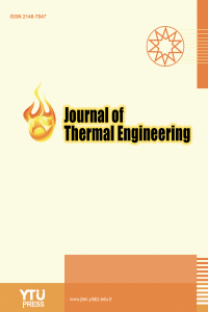Experimental study on a novel waterless solar collector
Experimental study on a novel waterless solar collector
Solar Energy, Solar Collectors, Salinity Gradient Solar Ponds,
___
- REFERENCES
- [1] Gude VG. Energy storage for desalination processes powered by renewable energy and waste heat sources. Appl Energy 2015;137:877–898.
- [2] Antipova E, Boer D, Cabeza LF, Gosalbez GG, Jimenez L. Multi-objective design of reverse osmosis plants integrated with solar Rankine cycles and thermal energy storage. Appl Energy 2013;102:1137–47.
- [3] Salata F, Coppi M. A first approach study on the desalination of sea water using heat transformers powered by solar ponds. Appl Energy 2014;136:611–618.
- [4] Sayer A, Al-Hussaini H, Campbell AN. New theoretical modelling of heat transfer in solar ponds. Sol Energy 2016;125:207–218.
- [5] Ghaffour N, Lattemann S, Missimer T, Kim CN, Sinha S, Amy G. Renewable energy-driven innovative energy-efficient desalination technologies. Appl Energy 2014;136:1155–1165.
- [6] Ganguly S, Date A, Akbarzadeh A. Heat recovery from ground below the solar pond. Sol Energy 2017;155:1254–1260.
- [7] Goswami R, Das R. Investigation of thermal and electrical performance in a salt gradient solar pond. J Phys Conf Ser 2019;1240:012111.
- [8] Goswami R, Das R. Experimental analysis of a novel solar pond driven thermoelectric energy system. J Energy Resour Technol 2020;142:121302.
- [9] Kumar A, Das R. Effect of peripheral heat conduction in salt-gradient solar ponds. J Energy Storage 2020;33:102084.
- [10] Rghif Y, Zeghmati B, Bahraoui F. Soret and Dufour effects on thermosolutal convection developed in a salt gradient solar pond. Int J Therm Sci 2021;161:106760.
- [11] Sayer A, Mahood H. Improved thermal efficiency of salinity gradient solar pond by suppressing surface evaporation using an air layer. Energy Eng 2020;117:367–379.
- [12] Faqeha H, Bawahab M, Vet QL, Faghih A, Date A, Akbarzadah A. An experimental study to establish a salt gradient solar pond (SGSP). Energy Procedia 2019;160:239–245.
- [13] Rawa MJH, Al-Turki YA, Abu-Hamdeh NH, Khoshvaght‐Aliabadi M, Alimoradi A. Enhancement of heat extraction from solar ponds by using twisted coil‐tubes. Environ Prog Sustain Energy 2021;40:13604.
- [14] Lu H, Swift AH, Hein HD, Walton JC. Advancements in salinity gradient solar pond technology based on sixteen years of operational experience. J Sol Energy Eng 2004;126:759–767.
- [15] Andrews J, Akbarzadeh A. Enhancing the thermal efficiency of solar ponds by extracting heat from the gradient layer. Sol Energy 2005;78:704–716.
- [16] Date A, Yaakob Y, Date A, Krishnapillai S, Akbarzadeh A. Heat extraction from Non-Convective and Lower Convective Zones of the solar pond: A transient study. Sol Energy 2013;97:517–528.
- [17] Sayer A, Monjezi A, Al-Hussaini H, Campbell A. Experimental and theoretical investigation of the temperature and concentration distributions of the upper and lower convective zones of a small salinity gradient solar pond covered with a thin liquid layer. Conference paper; IAPE '19, Oxford, United Kingdom. 2019.
- [18] Sayer A, Al-Hussaini H, Campbell A. The utilisation of statistics to estimate evaporation from the surface of solar ponds. Univ Thi-Qar J Sci 2021;8:161–169.
- [19] Kumar A, Singh K, Verma S, Das R. Inverse prediction and optimization analysis of a solar pond powering a thermoelectric generator. Sol Energy 2021;169:658–672.
- [20] Montalà M, Cortina JL, Akbarzadeh A, Valderrama C. Stability analysis of an industrial salinity gradient solar pond. Sol Energy 2019;180:216–225.
- [21] Sayer A, Al-Hussaini H, Campbell A. Experimental analysis of the temperature and concentration profiles in a salinity gradient solar pond with, and without a liquid cover to suppress evaporation. Sol Energy 2017;155:1354–1365.
- [22] Suarez F, Ruskowitz J, Childress A, Tyler S W. Understanding the expected performance of large–scale solar ponds from laboratory– scale observations and numerical modelling. Appl Energy 2014;117:1–10.
- [23] Ruskowitz J, Suarez F, Tyler SW, Childress AE. Evaporation suppression and solar energy collection in a salt-gradient solar pond. Sol Energy 2014;99:36–46.
- [24] Sayer A, Al-Dokheily ME, Mahood HB, Khadem HM, Campbell AN. The effect of a liquid cover on the thermal performance of a salinity gradient solar pond: An experimental study. Energ Eng 2022;119:17–34.
- [25] The Engineering ToolBox. Free tools and information for engineering and design of technical applications. 2001. Available at: www.engineeringtoolbox.com. Accessed Nov 14, 2023.
- [26] NASA EarthData ASDC. Surface meteorology and solar energy, a renewable energy resource. Available at: https://eosweb.larc.nasa.gov. Accessed Nov 14, 2023.
- Yayın Aralığı: 6
- Başlangıç: 2015
- Yayıncı: YILDIZ TEKNİK ÜNİVERSİTESİ
Manish Kumar CHAUHAN, Akhilesh Kumar CHAUHAN, Yunis KHAN, Abhendra Pratap SINGH
Experimental study on a novel waterless solar collector
Asaad H. SAYER, Wed AL-GRAITI, Hameed B. MAHOOD, Hameed B. MAHOOD, Alasdair N. CAMPBELL
Aram Soleimani VARKANEH, Ghanbar Ali SHEIKHZADEH NOOSHABADI, Ali Akbar Abbasian ARANİ
Design and development of air ventilated air bed for hospitalized patients
Darshan KARANJE, Shivroop PATIL, Shivraj GURSAL, Prafulla HATTE
Astick BANERJEE, Sanat Kumar MAHATO, Krishnendu BHATTACHARYYA, Sohita RAJPUT, Ajeet Kumar VERMA, Ali J. CHAMKHA
S. Mohamed ILLYAS, Kumaresan VELLAISAMY, A. MUTHUMANOKAR
Huda Majid HASAN, Basma Abbas ABDULMAJEED
Experimental study on heat transfer from rectangular fins in combined convection
Mehdi BASIRI, Hamid Reza GOSHAYESHI, Issa CHAER, Hadi POURPASHA, Saeed Zeinali HERIS
